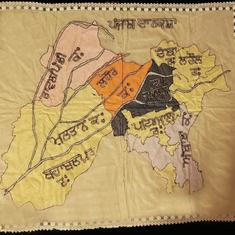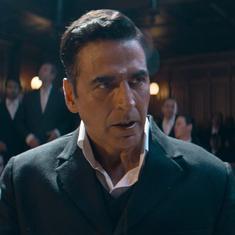The event is a night-long jagraata: a performance of song and dance to celebrate the month of Dalit icon BR Ambedkar’s 125th birth anniversary. The man on the stage is Manjeet Mehra, the head of the cultural wing of the Bahujan Samaj Party.
It is a busy month for Mehra. He and his troupe have been travelling to remote parts of Haryana and Uttar Pradesh to perform for the Dalit community. After a string of events in Rajasthan, his tour will culminate at the Deekshabhoomi in Nagpur, where Ambedkar converted to Buddhism along with 500,000 followers in 1956 to escape the caste system.
Upper-caste groups “use fancy posters, lights, stage to eulogise the unjust acts of Hindu Gods and Goddesses”, said Mehra. “They organise durbars to lure our youth. We are using the same jagraatas and durbars to spread Ambedkar’s message, to enlighten our youth.”
New interpretations
Mehra has modeled himself on Narendra Chanchal, the flamboyant jagraata singer who transformed the tradition of bhajan singing into a multi-million industry in North India in the ’90s. In his events, Mehra deconstructs events from history and mythology for Bahujans, his preferred term for Dalits, and interprets their political significance. “Most of our people cannot read and write,” he said. “They neither get a chance to look beyond popular perceptions. I use the same popular gimmicks to make them aware of their rights and duties.”
Mehra kept switching registers, moving between songs and standup comedy. Each time he picked a reference from the Hindu epics, he reiterated, “It is not me who is saying this, it is their own holy texts.” In one sequence, he said, “Their Lord Ram went on an exile but who did he kill in those 14 years? Our Dalit rulers. Taadka, Maarich, Bali-Sugreev, Shambukh. Still he is God. No one talks about it. It is a way to erase the Dalit history for convenience.”
Donations, starting from Rs 10, started to pour in as he sang. He asked one of the contributors his name. “Dharam Pal,” the man replied. Mehra continued, “You know, 50 years ago, we couldn’t have such beautiful names. A Brahmin with zero intelligence would be called Brahm Gyaani, a Kshatriya child even if coward would be named Veer Singh. But a Dalit would have go to his upper-caste zamindar to ask him to name his children. That zamindar would ask the day the child was born. If it was Budhwar [Wednesday], he would be called Buddhu. If it was Shukrawar [Thursday] then Shakku. That is how we were named then.” Banter like this fired up the crowd.
When the crowd becomes restless, Mehra imitated Bollywood actor Amrish Puri’s famous bit of dialogue to announce, “Mogambo dukhi hua.” Mogambo is disappointed. Canned laughter played in the background. The crowd’s attention was wrested back with this device several times during the night.
The great emancipator
Mehra turned to address the women,sitting together on the left side. They were more than 500 of them, a rarity in political events in Uttar Pradesh, that too so late at night, except for those addressed by Mayawati. He told them that it was Ambedkar who ensured equality for Indian women when he crafted the Constitution. “Mothers and sisters, according to Babasaheb, the sari that you wear is meant to hold you back from running away unlike the jeans-pant,” he said.
Mehra, 40, has come a long way from the time he was a teacher of arts and crafts. That was 14 years ago. The performer was born into a Dalit family in Chiri village in Rohtak and attended a government school. He decided to kick his steady job and become a musician after coming under the influence of the Dalit leader Kanshi Ram, whose interpretation of Ambedkar the young man especially admired.
Since then, he has been researching Dalit history and turning it into songs and acts. “My songs involve all those who helped the poor ‒ Guru Ravidass, Jyotiba Phule, Kabir,” he said. His songs are lucid, often simplistic, angry and accusatory, written with a popular audience in mind. They prompt the listeners to ask uncomfortable questions.
At the jagraata, Mehra doesn’t perform all night. As he takes quick naps, Dalit leaders make speeches and other performers belt out Gautam Buddha bhajans .On Monday night, a boy took to the stage to sing a tune about the devotees of Asaram Bapu, the so-called godman who has been accused of rape. Once he was done, Mehra mimicked Asaram and then proceeded to mock the recently arrested Haryana godman Rampal. “The boy sang well but it also shows who conmen are successfully luring our youth by polluting their heads with Manuwadi rituals and servility,” Mehra observed.
The last act of the night, at 3 am, described the life story of Bhim Rao Ambedkar, the community’s great champion. Mehra described him as “gol, matol, ghungraale baal and chauda seena” ‒ a chubby, curly-haired, broa- chested child. Putting a basket full of cow-dung cakes on his head, he narrated the story of Ramabai, Ambedkar’s first wife, who earned the scorn of the neighbourhood by using the patties as fuel when her husband was studying in America and the family was short of money. Mehra went on to talk about how Gandhi opposed the idea of a separate electorate for Dalits even though this could have empowered the community. “That Gandhi did not want rights for us,” Mehra said. “He wanted us to be at his mercy.”
Broad stereotypes
Despite his activist streak, Mehra is not untouched by the entertainment industry. He produced an album last year and in 2011, he co-directed a popular Haryanvi film, Dhaakad Chorra, brimming with gun-flashing machismo. The same virile references are present in his performances. He portrays the opponents of Dalits as effeminate and characterises upper-case women as people “who waste time on lipstick and nail polish”.
The popularity of his jagraatas reflects the growing confidence of Dalit communities across the country. Monday night’s jagraata was held in a part of Muzaffarnagar that was torn apart by riots in September. It isn’t certain whether the empathy and anger in these songs can start a social revolution. But it’s clear that the jagraatas have created an energetic, sometimes emancipating ,alternate culture.
As Mehra wrapped up, he took a sip of water from a Bisleri bottle. “Today, we are drinking Bisleri water,” he said. “Fifty years ago, we were not even allowed clean water by the upper castes.” Then he began to sing, “Phir bhi Bhim kyun na yaad aaya?’ Why did we, then, not remember that Bhim?










